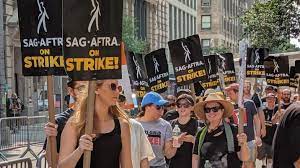If you’re a film fanatic, or just someone who enjoys obsessing over your favorite actors, you may know about the Hollywood actors strike. On July 14, the members of SAG-AFTRA (Screen Actors Guild – American Federation of Television and Radio Artists) took it upon themselves to boycott streaming platforms, as well as other corrupt members of the film industry. This strike started because of the inadequate wages that many actors were earning, as well as the unsafe working conditions that many were working in. As of July 14, actors refrained from taking on new projects, as well as from promoting any projects coming out. Over the months that followed, many projects were postponed, and some were even put on hold indefinitely. However, as of November 10, the strike has come to an end, with a long-awaited contract.
On that day, the SAG-AFTRA national board held a conference with the Alliance of Motion Picture and Television Producers (AMPTP) and came to a preliminary agreement concerning the 2023 TV/Theatrical Contracts. The president of the actors’ union Fran Drescher shared information about the deal at a conference. “I knew a long time ago that this was going to be a seminal deal,” Drescher told The Washington Post, “because the times that we’re living in demanded one.” Some of the executives who engaged in negotiations were Bob Iger of Disney, Donna Langley of NBCUniversal Studio Group, Ted Sarandos of Netflix, and David Zaslav of Warner Bros. Discovery.
The contract includes increases in minimum compensation, streaming bonuses, and limits on artificial intelligence usage, generally increasing opportunities for actors and improving the conditions that they work in.
As stipulated in the contract, there will be an instant 7% pay raise for performers. On July 1, 2024, there will be a further 4% increase in compensation, and on July 1, 2025, there will be a 3.5% increase. The pay increases for background actors, stand-ins, and photo doubles will start at 11% right away and go up to 4% more and 3.5% more for general performers in 2024 and 2025.
According to the new contract, actors who participate in streaming projects that get a sizable viewership will also receive “a success payment” in addition to their regular residual income. A new streaming payment distribution fund will be established to reward performers 75% of any bonus money. With compensation from streaming services being a large topic of discussion among actors, this is an important point in the contract.
SAG-AFTRA has also outlined limits on the use of artificial intelligence. According to the guild, “AI [is taking] new forms with unprecedented capabilities, [and] SAG-AFTRA is dedicated to establishing the broadest possible protections for professional performers’ voices, likenesses and performances.” The contract helps hinder unauthorized replication or duplication, and acts as a foundation for future negotiations on AI in the film industry.
The contract took other issues into account, resulting in benefits such as better health insurance, relocation bonuses, and increases in opportunities for extras/background characters. All of these improvements, in turn, improve the environment that actors work in and their lives. They offer resources that help incorporate necessities that were previously unavailable.
Although there were wins that came out of this contract, SAG-AFTRA did not achieve all of the goals it was aiming for. For instance, the guild did not secure a share of streaming revenue, which was a prime concern for Drescher. “This is an ongoing, living thing, a contract,” she said in The Post, “and we’re not over.”













































































































































